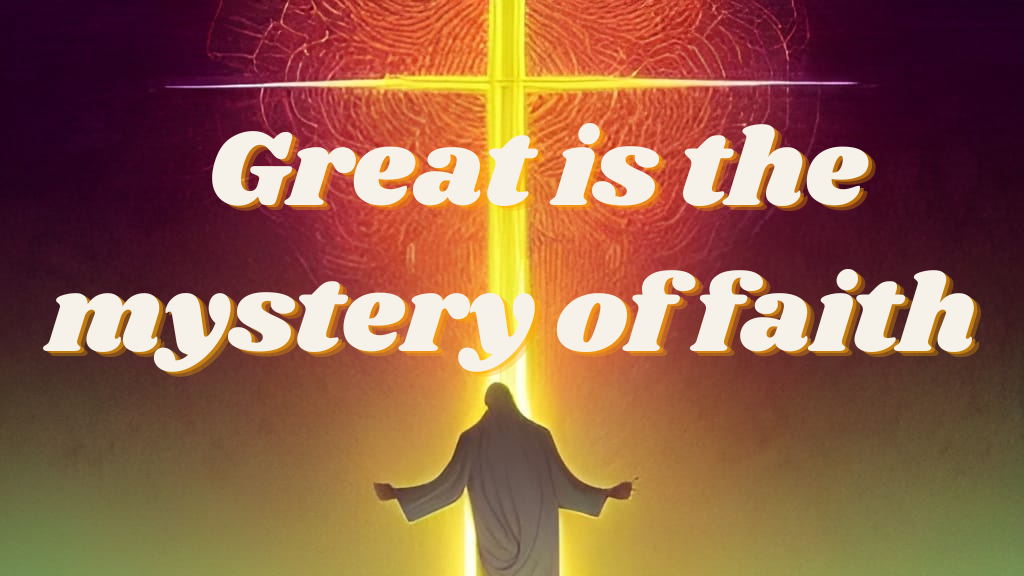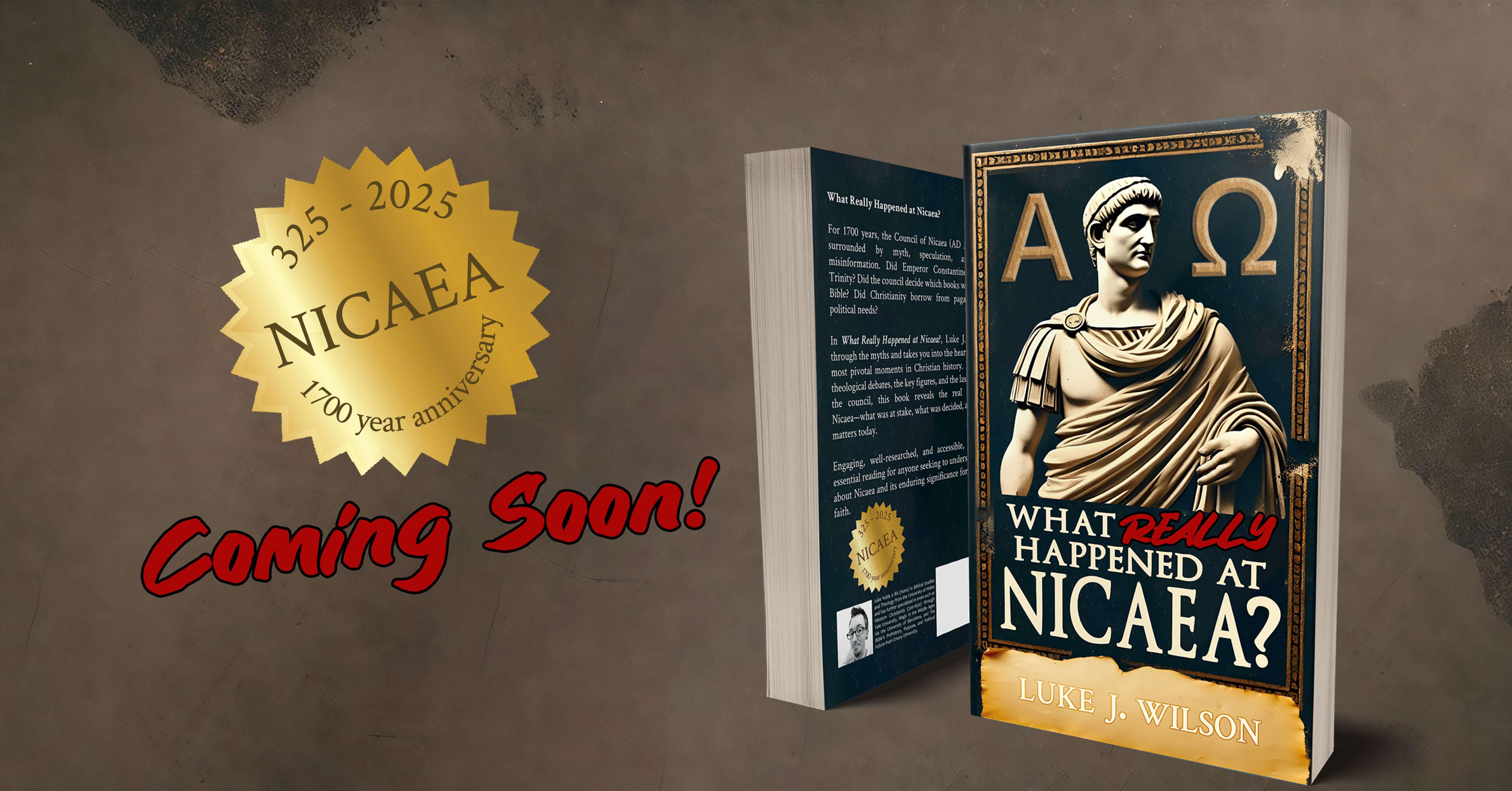Creedal Christians: Introduction

I’m starting a new four part series over the coming weeks which will be looking at the different historical creeds of the Church which have been recited, used and handed down for two millennia, beginning with the very first formal creed: the Apostles Creed. This series will be a mixture of historical background plus a commentary on the creed itself to see where each statement is based in Scripture, and why we can trust them to accurately portray the Faith.
What are creeds and why should we accept them?
The word “creed” comes from the Old English crēda, and from Latin crēdo meaning “I believe”. A creed is basically a set of beliefs which you profess; a statement of faith. Many non-creedal (or non-denominational) churches have a ‘statement of faith’ on their websites to highlight and specify where they stand on certain doctrines – which is essentially just stating their own type of creed instead of listing an ancient and historically accepted one. Even those who declare “no creed but Christ”, or “I just believe the Bible”, are ironically making a creed, albeit a short one with no solid definition.
The Church has been declaring creeds for as long as it has existed, despite the sometimes common accusation that creeds are “unbiblical” or “non-biblical”; statements which couldn’t be further from the truth! Even in the Apostles time they were making statements of faith in short creedal formats, and a few of them are preserved in the New Testament, primarily in Paul's letters. One of the longer examples can be found in the first letter to the Corinthians, and has a similar form and wording to what came to be known as the Apostle’s Creed:
1 Corinthians 15:3-8
For I passed on to you as most important what I also received:
that Christ died for our sins
according to the Scriptures,
that He was buried,
that He was raised on the third day
according to the Scriptures,
and that He appeared to Cephas,
then to the Twelve.
Then He appeared to over 500 brothers at one time;
most of them are still alive,
but some have fallen asleep.
Then He appeared to James,
then to all the apostles.
Last of all, as to one abnormally born,
He also appeared to me.
That places this creed well within the first 20-30 years after the crucifixion and resurrection, and is thus one of the earliest examples of orthodoxy and eye-witness accounts we have, possibly pre-dating the writing of the New Testament itself. The way Paul begins this passage with the “I passed on what I received” formula shows that this was an already existing set of established beliefs which were passed onto him, and which he now passes onto the Corinthians. Paul wasn’t just making this up, or summarising what he believed – no, this was, and is, a great example of the faith of the Early Church most likely passed around as oral history, which was handed to them by the eye-witness Apostles themselves. These creeds were eventually used in the daily liturgy and worship of the Church as part of baptisms and hymns, and were also expected to be committed to memory by new converts to the faith.
Another well-known example of what could be arguably a creed of sorts, is found in Galatians 3:28 which, upon further inspection, appears to contradict and oppose the more popular expressions and "blessings" that were used by Greeks and Jews of his day.
Contrast Paul's wording to the Galatians...
"There is no longer Jew or Greek, there is no longer slave or free, there is no longer male and female; for all of you are one in Christ Jesus." (Apostle Paul, Gal 3:28)
With that of the Greek and Jewish sayings:
“There are three blessings for which I am grateful to fortune: First, that I was born a human being and not one of the brutes; Next, that I was born a man and not a woman; Thirdly, a Greek and not a barbarian” (A quote attributed to Socrates or Thales; Diogenes Laertius, Thales 1.33).
“Blessed are you, Lord, our God, ruler of the universe who has not created me a woman.” (This appears as part of a sequence of blessings found in the Talmud, which men would recite in their morning prayers)
There’s also other examples of early New Testament creeds, of various lengths, which can be found in: 1 Corinthians 8:6; 1 Corinthians 11:23-29; Romans 1:3-4; 10:9; 1 Timothy 3:16, 2 Timothy 2:8; and possibly the more well known one, in Philippians 2:6-11. I encourage you to look them up and read them all, as you’ll see that short, statement based clear expressions of doctrine and belief are intertwined with the Scriptures and life of the Church since the very start. Having more formalised versions just came out of an already existing practice and often had various reasons behind them being required. We’ll look more into those reasons as we carry on through this series and examine each creed in more detail.
The creeds I’ll be covering in the coming weeks will be:
- The Apostles Creed
- The Nicene Creed
- The Athanasian Creed
- The Chalcedonian Creed
Don’t forget to subscribe using the form below so that you don’t miss any updates!
Further reading:
- http://coldcasechristianity.com/2014/the-importance-and-early-use-of-creeds/
- http://www.evidencesforchristianity.org/new-testament-creeds.html
- https://www.quora.com/Was-the-Bible-deliberately-altered-for-political-purposes-or-to-support-one-theology-over-another/answer/Jenny-Hawkins-4?share=844f3f03&srid=BVI7
- https://www.loebclassics.com/view/diogenes_laertius-lives_eminent_philosophers_book_i_chapter_1_thales/1925/pb_LCL184.35.xml
- https://www.myjewishlearning.com/article/who-has-not-made-me-a-woman/
Leave a comment Like Back to Top Seen 2.9K times Liked 0 times
Enjoying this? Consider contributing regular gifts for this content on Patreon.
* Patreon is a way to join your favorite creator's community and pay them for making the stuff you love. You can simply pay a few pounds per month or per post that a creator makes, and in return receive some perks!
Subscribe to Updates
If you enjoyed this, why not subscribe to free email updates and join over 831 subscribers today!
My new book is out now! Order today wherever you get books
Recent Posts
Luke J. Wilson | 24 hours ago | History
We often hear that Jesus was “about 33 years old” when he was crucified and only had a three-year ministry. But have you ever wondered how precise that number is, or why we assume that was his age, especially when Scripture doesn’t specify? Table of Contents The Gospel of Luke: “About Thirty” Early Church Testimony: Irenaeus and the Longer Ministry Historical Anchors: Birth, Pilate, and the Crucifixion Window The Death of Herod Cross-referencing with Pilate, Caiaphas, and Jesus When Did Tiberius Begin to Reign? 1. From his co-regency with Augustus (AD 11–12) 2. From the death of Augustus (AD 14) How Does This Affect Jesus’ Age and Ministry Start? Astronomy and the Timing of Passover Estimated Lengths of Jesus’ Ministry Why This Matters In Summary Further Reading I’ve long wondered about this, especially when the Pharisees accused Jesus of not being close to fifty, which seems odd if he was only in his early 30s. Then I later discovered Irenaeus also had similar thoughts in the second century, and the plot thickened! I’ve had this rumbling around in the back of my mind for a few years now and slowly chewed it over. So now I’m going to try and present the evidence, rather than rely solely on tradition and assumptions, and piece together what the Gospels, early Church Fathers, historical data, and even astronomy can tell us about the potential age of Jesus and the length of his ministry. What follows is a deeper, richer look at the life and death of Jesus and what we can learn by following the evidence. The Gospel of Luke: “About Thirty” Luke 3:23 tells us plainly: Jesus was about thirty years old when he began his work. This statement has historically been the anchor point for dating Jesus’ ministry. Most take this to mean he was around 30 at his baptism, which marked the beginning of his public ministry. Something to bear in mind here is that Luke isn’t exact and only says “about thirty”, so he could have been slightly younger or older at the time. But being around the age of 30 would align with the requirements of priests, which Jesus was also fulfilling the role of (Hebrews 2:17; Numbers 4:1–4; Numbers 8:23–25). But from there, it’s traditionally assumed that Jesus ministered for just three years before his death, mainly based on the Gospel of John, which mentions three Passovers (John 2:13, 6:4, 11:55). However, John also says at the end of his Gospel in John 21:25: But there are also many other things that Jesus did; if every one of them were written down, I suppose that the world itself could not contain the books that would be written. This is a clear reminder, even if John is being hyperbolic here: not everything was recorded. Considering that the Synoptic Gospels only mention one Passover, the number of Passovers we read about in John may not reflect the total number Jesus experienced during his ministry. They may also serve a theological point (three being a prominent number in Scripture) rather than a chronological one. Early Church Testimony: Irenaeus and the Longer Ministry In the second century, Irenaeus, bishop of Lyon and disciple of Polycarp (who had also known the Apostle John and was likely his disciple), made an interesting claim about the age of Jesus — and backed it up by saying it was verified by the Apostle John himself! In Against Heresies (2.22.4–6), Irenaeus wrote: …our Lord possessed [old age] while He still fulfilled the office of a Teacher, even as the Gospel and all the elders testify, those who were conversant in Asia with John, the disciple of the Lord, [affirming] that John conveyed to them that information. … Some of them, moreover, saw not only John but the other apostles also, and heard the same account from them, and bear testimony to this statement. He argued that the line in John 8:57: Then the Jews said to him, ‘You are not yet fifty years old, and have you seen Abraha...
KingsServant | 12th March 2025 | Islam
This is a guest post by “KingsServant” In 2019 a book called Defying Jihad was published by Tyndale House, the reputable Christian publisher telling the story of “Esther Ahmad” a pseudonym used by the author alongside her co-author Craig Borlase, who has previously written alongside, well known Christian personalities such as Matt Redman the singer and Andrew Brunson, an American pastor imprisoned by the Turkish government. As I began to read this book over this past year I was expecting an encouraging account of how a former Jihadi found Christ and escaped her previous accomplices. Very quickly, however, I became uncomfortable, her descriptions of her background involved allegedly committed Muslims doing very un-Islamic things and the unnamed militant group doing unusual things that didn’t fit my knowledge gained from years of study of Islam and interactions with Muslims, including extremists. As my doubts about the authenticity of the book solidified, and yet I couldn’t find anyone else who had questioned these things before me, or on the other hand provided verification of her story. I decided to contact Craig. During our brief and cordial email exchange he told me that he had been in touch with people who knew Esther after she escaped her family home, but so far has not suggested he has any other lines of evidence confirming any of the key elements of her account before that time. As a result, I am writing this article to draw attention to the aspects that raise suspicion. According to “Esther’s” story, she was raised in Pakistan where she was sent to an extremist madrassa (or Muslim school) for girls, there they were shown images of victims of violence and told that Christians and Jews were responsible - the emphasis on Jews and particularly Christians by a militant group based in Pakistan is strange. All the terrorist groups in Pakistan direct their efforts towards Hindus (especially in Kashmir) or other Muslims, since Christians are such a tiny minority there. Things rapidly become even stranger when a Mullah displays weapons to the group of girls telling them “… one day you will get to handle these” as the book continues describing them being encouraged to aspire to physical violence towards Jews and Christians specifically, the description of “Aunt Selma” volunteering for and dying fighting Jihad is likewise out of place. Islamic terrorist groups very rarely recruit women for combat roles, as Devorah Margolin describes Hamas and ISIS as departing from convention by encouraging female participation in violence and even then in only a very restricted way under particular circumstances with a specific fatwa (or Islamic ruling) being issued.1 On page 33, the militant group leader “Anwar” suggests that Esther could find a husband in the west to bring him to Islam. It is strictly forbidden for a Muslim woman to marry a non Muslim man, the idea that they would be encouraged by a scholar to date is about as unbelievable. In a conservative Pakistani culture, she would more likely find herself the victim of a so-called “honour killing” for such a thing.2 After her initial chance encounters with her future husband “John” (not as a result of trying to follow “Anwar’s” advice), on page 92 it is recorded that he said to her “… I’m not against your faith and beliefs…”, it’s the kind of thing that we might expect a liberal in the west to say, but not a Pakistani believer who knows that Islam denies that Jesus is the Son of God and that he died for sinners. Following her conversion according to her account, she engaged in a number of public debates with clerics in which she defended her decision to leave Islam and follow Christ. It is not uncommon for apostates to have meetings with scholars arranged by their family members in the hope that they might be won back to Islam, but it is very surprising that her influential father would want to give his apostate daughter su...
Luke J. Wilson | 05th March 2025 | Lent
Ash Wednesday marks the beginning of Lent, a season of repentance, fasting, and preparation for Easter in the Christian calendar. It is observed by many Western Christian traditions, including the Roman Catholic Church, Anglican Communion, Lutheran churches, and some Methodist and Reformed communities. The day falls 46 days before Easter Sunday and is always on a Wednesday. Origins and Historical Development The practice of Ash Wednesday can be traced back to the early centuries of Christianity, though its formal observance developed over time. The use of ashes as a sign of repentance has deep biblical roots, appearing frequently in the Old Testament. People would cover themselves with ashes as an outward sign of sorrow for sin and a desire to turn back to God (e.g., Job 42:6, Daniel 9:3, Jonah 3:6). By the 8th century, the imposition of ashes on the forehead became a common practice in the Western Church. Pope Urban II (r. 1088–1099) helped formalise Ash Wednesday as the official beginning of Lent, reinforcing the idea of a season of penitence leading up to Easter. The name “Ash Wednesday” itself comes from the tradition of marking the faithful with ashes, typically in the shape of a cross, while the priest or minister recites words such as, “Remember that you are dust, and to dust you shall return” (Genesis 3:19) or “Repent, and believe in the Gospel” (Mark 1:15). The Lenten Fast Fasting has always been a central aspect of Lent, and by the time of the Council of Nicaea (AD 325), a forty-day period of fasting before Easter had become a standard part of Church practice. This was based on the example of Jesus’ forty days in the wilderness (Matthew 4:1–2) and was intended to prepare believers spiritually for the Passion and Resurrection of Christ. Athanasius, the great bishop of Alexandria, regularly wrote paschal (Easter) letters to the churches to encourage fasting, self-control, and moderation during this period. His writings provide valuable insight into how Lent was observed in the early Church and confirm that the practice was well established long before later claims that it had pagan origins. In one of his letters, written around AD 332, he describes the structure of the Lenten fast: The beginning of the fast of forty days is on the fifth of the month Phamenoth [Ash Wednesday]; and when, as I have said, we have first been purified and prepared by those days, we begin the holy week of the great Easter on the tenth of the month Pharmuthi [Palm Sunday], in which, my beloved brethren, we should use more prolonged prayers, and fastings… — Athanasius, Letter III (c. AD 332) The early Lenten fast was stricter than modern observances. Many early Christians abstained not only from meat but also from dairy, eggs, and wine. In some traditions, believers ate only one meal per day, typically in the evening. While practices have evolved over time, the principle remains the same: Lent is a time of self-discipline, spiritual renewal, and preparation for Easter. Meaning and Observance of Ash Wednesday Ash Wednesday serves as a solemn reminder of human mortality and the need for repentance. The ashes, often made by burning the palm branches from the previous year’s Palm Sunday, symbolise both death and the hope of renewal in Christ. The day is also marked by fasting and abstinence in many traditions, such as within Roman Catholicism and Eastern Orthodoxy, the faithful are required to fast and to abstain from meat and dairy on various days. Many other denominations encourage similar practices or personal acts of self-denial as a way of focusing on spiritual growth. Churches hold special services where worshippers receive the imposition of ashes. The act is not merely ritualistic but is meant to be a public declaration of one’s commitment to turn away from sin and seek God’s grace. Greek Orthodox Yearly Fasting Calendar (2025). Fasting isn’t just for Lent! An Anglican Perspective The Ch...
Luke J. Wilson | 28th February 2025 | Early Church
The Bible is often described as “God-breathed,” a phrase taken from 2 Timothy 3:16: “All scripture is inspired by God and is useful for teaching, for reproof, for correction, and for training in righteousness.” But what does it mean for Scripture to be “inspired,” and how did the books of the Bible come to be recognised as part of the canon — the authoritative collection of writings that make up the Bible? Were they really “decided” at the Council of Nicaea, as some popular myths claim? Table of Contents Understanding Biblical Inspiration What is the Canon? The Septuagint and the Deuterocanonical Books How Were the Books of the Bible Selected? Why Were Some Books Excluded? Has the Bible Been Edited or Corrupted Over Time? Did the Church Decide the Canon at Nicaea? Conclusion Further Reading Understanding Biblical Inspiration A helpful analogy for inspiration is that of an architect designing a great building. Consider St. Paul’s Cathedral in London — Christopher Wren was the architect who planned and designed it, yet he himself did not lay a single brick. Instead, countless workers followed his design to bring the cathedral into existence. Similarly, God is the ultimate author of Scripture, yet He worked through human writers to bring His message to us. The Holy Spirit inspired them, guiding their words while allowing their personalities, historical context, and literary style to remain evident in their writings. This means that while the Bible is written by human hands, it carries divine authority because its true source is God Himself. The process of inspiration does not mean God dictated each word like a secretary taking notes, or by possessing the authors, but rather that He ensured the truth of His message was faithfully recorded by the biblical writers. What is the Canon? The word “canon” comes from the Greek κανών (kanōn), meaning “rule” or “measuring rod.” In the context of the Bible, the canon refers to the official list of books recognised as divinely inspired and authoritative for faith and practice. The canon developed over time as the early church recognised which writings carried divine authority. The Old Testament canon was largely settled by the time of Jesus, based on the Hebrew Scriptures used in the Jewish community. The New Testament canon, however, was formed through a process of discernment over several centuries, as the church recognised which writings were truly inspired and authoritative. The Septuagint and the Deuterocanonical Books The Septuagint (LXX) is the Greek translation of the Hebrew Scriptures, produced in the 3rd-2nd centuries BC. It was widely used by Greek-speaking Jews and later by early Christians, including the apostles. The Septuagint included several books not found in the Hebrew Bible, known as the Deuterocanonical books (such as Tobit, Judith, Wisdom, and 1–2 Maccabees). While these books were accepted in many early Christian communities and remain part of the canon in Catholic and Orthodox traditions, Protestant reformers later removed them, considering them useful but not divinely inspired at the same level as the rest of Scripture. The reformers’ view was influenced by Jerome, who, in the 4th century, argued that these books were not part of the Hebrew Bible and therefore should be considered separate. However, he still included them in his Latin Vulgate translation, recognising their historical and devotional value. The Reformers followed Jerome’s stance, moving these books into a separate section rather than outright removing them. It was not until the 19th century that an American Bible Society, citing printing costs and other practical considerations, physically removed these books entirely from Protestant Bibles. This decision solidified what is now commonly referred to as the “Protestant canon” of 66 books. And the other Books (as Hierome saith) the Church doth read for example o...









